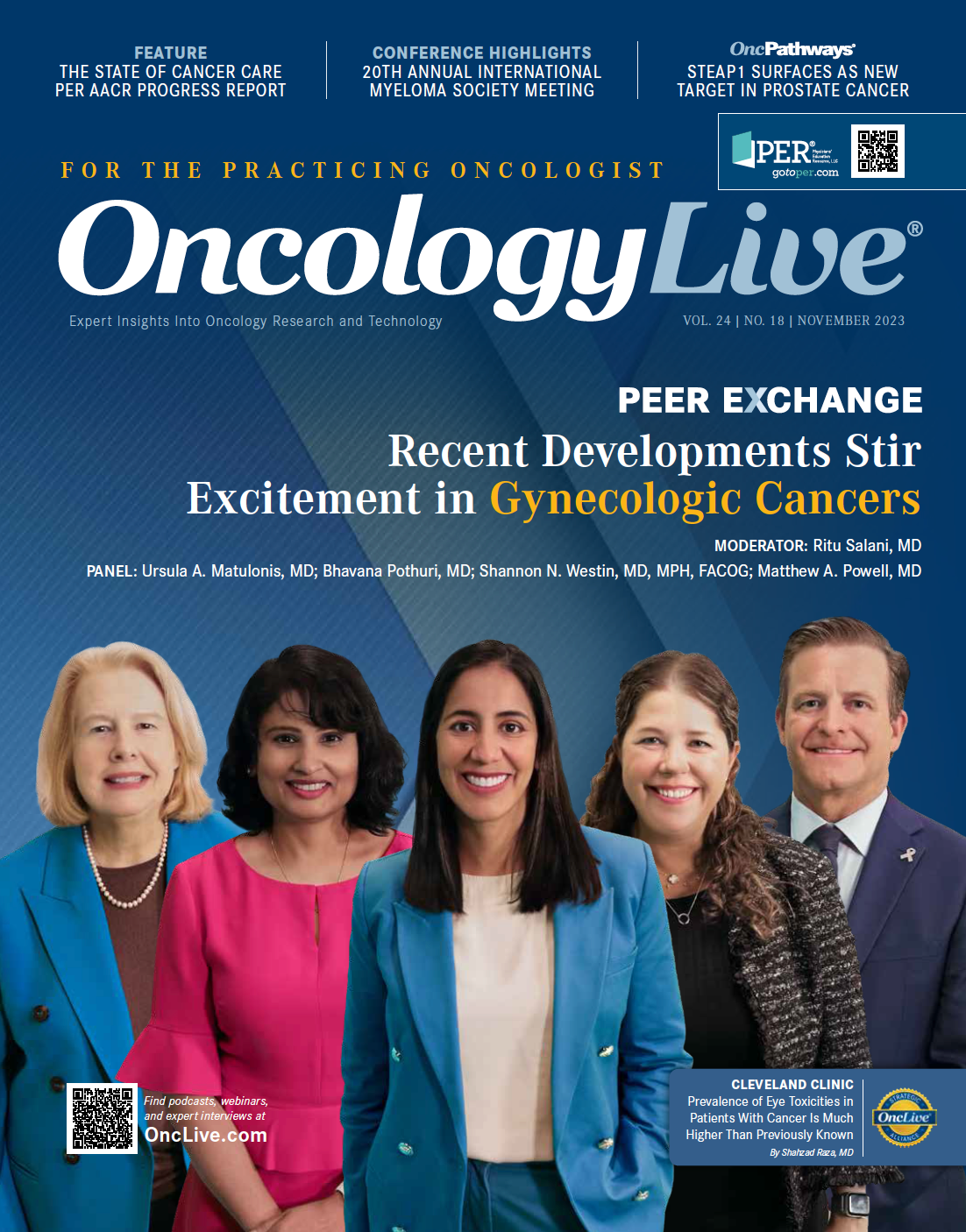Publication
Article
Oncology Live®
Reality Takes a Back Seat to Rhetoric Used in Objective Assessments of Cancer Treatment
Author(s):
It is time for society to address the critical nature of our current unsustainable oncology pharmaceutical marketplace, and it is also essential that whatever solutions are proposed and implemented do not incorporate inappropriate labeling of outcomes that negate meaningful measures of clinical benefit.
Maurie Markman, MD

It is difficult to contemplate a health care environment in this country with a fundamental approach to the development of new therapeutic strategies that is not firmly based on well-conceived, well-designed, and well-conducted clinical trials with results that are reported in peer-reviewed literature.
Further, it is widely and reasonably acknowledged that the highest level of evidence in the clinical trials arena is provided through outcomes obtained in phase 3 randomized clinical trials. These trials compare an existing standard of care at a given point in time in a specific clinical setting to 1 or more alternatives believed to potentially be superior (based on the objective evaluation of earlier research efforts) to this standard. Historically it has been the outcomes of such trials that formed the foundation of scientifically based modern medicine.
Throughout multiple decades, cancer care has been, and will surely continue to be, the poster child for the success of this clinical investigative paradigm. Older approaches to disease management in particular settings are potentially discarded, modified, or supplemented based on the favorable results of new generations of innovative studies published in high-impact general medical or oncology journals.
Unfortunately, the lofty rhetoric—as truthful as it may be in the aggregate and evaluated over a relatively long period of time—may mask certain realities that challenge the simplicity of the language used to communicate the clinical meaning and declared objectivity of outcomes reported to scientific and clinical colleagues, policy makers, payers, patients, and families.
Frequently employed buzzwords in research manuscripts and high-impact journal commentaries include such terms as statistically significant, validated end points, quality of life, clinically meaningful, confirmatory trials, complete vs partial response, and surrogate measures.1 Consider, for example, the term overall survival (OS) as used to describe the primary end point of a phase 3 oncology study comparing an established regimen of drug A plus drug B to a novel strategy of drug A plus drug C, an investigative agent not yet approved by the FDA for commercial sale.
There will be no debate that a major—even the main—goal of a therapeutic regimen for patients with advanced cancer would be to meaningfully improve their survival, if not to ultimately achieve the state of cure for the disease. This specific consideration justifies the use of OS as a primary end point within a randomized trial’s statistical design.
But now we turn away from the quite understandable rhetoric and deal with the reality of clinical investigation and mandatory ethical care, at least in the United States.
It would be possible to use a number of known experiences to emphasize the changing nature of OS as a valid study end point, but for this exercise, this commentator has selected his area of clinical and research interest: epithelial ovarian cancer.
In 1996, the gynecologic oncology world was upended following the publication of findings from a landmark study revealing that first-line administration of cisplatin (drug A) plus paclitaxel (the experimental drug C) in advanced disease improved both progression-free survival (PFS; median 18 months vs 13 months; P < .001) and OS (median 38 months vs 24 months; P < .001) compared with cisplatin (drug A) plus cyclophosphamide (drug B), the standard-of-care trial control arm.2
Because it was recognized at the time this study was initiated that second-line chemotherapy after the delivery of a platinum agent in advanced ovarian cancer was, at best, of marginal utility, it was not surprising that improved PFS, a so-called surrogate end point, would quite easily translate into improved OS, the declared true measure of clinical benefit.
However, the rarely discussed Gynecologic Oncology Group trial that immediately followed the landmark study—conducted by the same group of clinical investigators in an essentially identical patient population in terms of eligibility and ineligibility criteria comparing initial treatment with single-agent cisplatin (drug A) vs single-agent paclitaxel (drug B) vs the combination of cisplatin plus paclitaxel—unfortunately revealed a strikingly different survival outcome. Although patients randomly assigned to single-agent cisplatin experienced a significantly superior PFS (P < .001) compared with single-agent paclitaxel, there was no difference in OS between the treatment groups (P = .31).3
Why did this study totally fail to substantiate the utility of PFS as a surrogate for OS? Did the trial’s results indicate there was no survival impact associated with the new drug paclitaxel? Was the prior study simply wrong in its conclusions?
Of course, the answers to these questions are quite clear, and they have nothing to do with the strange labeling of PFS as a surrogate or with any difficulty interpreting outstanding clinical investigation. In this second trial, patients initially receiving paclitaxel who failed to respond or progressed following an initial response were offered the opportunity, assuming medically appropriate to do so, to cross over to receive cisplatin. As a result, patients randomly assigned to what was found to be the inferior treatment regimen were subsequently provided the opportunity, as ethically mandated, to benefit from the antineoplastic effects of the superior single agent.
The critical point to be made here—and the response to academics and others who continue to focus on OS as an end point—is that the delivery of effective treatment after a patient has been removed from a clinical trial may have a meaningful impact on their ultimate survival outcome. In fact, as observed with the experience above, the failure to see a trial-associated difference in OS was not an indication of failure to demonstrate the superiority of one treatment regimen vs another, but rather evidence that all study patient groups ultimately benefited from the multiple therapeutic strategies administered along the continuum of their care journeys.
With increasingly effective second-line or later strategies available in the oncologist’s armamentarium after a patient ends participation in a therapeutic trial, it is reasonable to seriously challenge the concept that OS should continue to be considered the gold standard metric in a randomized trial.
Finally, it is relevant to briefly acknowledge that the vocabulary employed to interpret clinical trial outcomes is frequently linked in academic and policy discussions to the prices set by manufacturers of newly approved patent-protected pharmaceutical agents. Some have vigorously challenged favorable regulatory decisions for increasingly expensive anticancer agents that have been shown in studies to “improve PFS in the absence of statistically significant differences in OS.”
It is surely time for society to directly address the critical nature of our current unsustainable oncology pharmaceutical marketplace, and it is also essential that whatever solutions are proposed and implemented do not incorporate inappropriate labeling of outcomes that negate meaningful measures of clinical benefit.4
Maurie Markman, MD, is president of Medicine & Science at City of Hope, Atlanta, Chicago, Phoenix
References
- Gyawali B, Kesselheim AS, Ross JS. The accelerated approval program for cancer drugs — finding the right balance. N Engl J Med. 2023;389(11):968-971. doi:10.1056/NEJMp2306872
- McGuire WP, Hoskins WJ, Brady MF, et al. Cyclophosphamide and cisplatin compared with paclitaxel and cisplatin in patients with stage III and stage IV ovarian cancer. N Engl J Med. 1996; 334(1):1-6. doi:10.1056/NEJM199601043340101
- Muggia FM, Braly PS, Brady MF, et al. Phase III randomized study of cisplatin versus paclitaxel versus cisplatin and paclitaxel in patients with suboptimal stage III or IV ovarian cancer: a Gynecologic Oncology Group study. J Clin Oncol. 2000;18(1):106-115. doi:10.1200/JCO.18.1.106
- Mathews AW. Employers’ health-plan costs to swell. Wall Street Journal. September 6, 2023. Accessed October 16, 2023. https://www.wsj.com/public/resources/documents/ROT8DV3i7ppUyhF6koI2-WSJNews-Paper-9-8-2023.pdf










